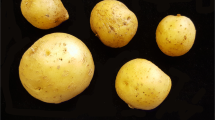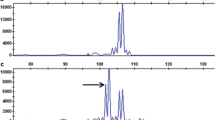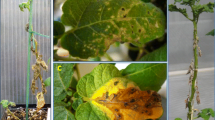Abstract
Genes conferring resistance to Potato virus X (PVX) are known, but it remains unknown whether these genes also confer resistance to the migration of PVX from potato leaves to tubers. Potato leaves of 43 cultivars and breeding lines were inoculated with PVXo and PVXb strains and their subsequent appearance in tubers was assessed. Then, a sequence-characterized amplified region (SCAR) marker was developed, and the nucleotide sequence of the SCAR marker was compared with the sequences of known PVX resistance genes. Eleven cultivars and breeding lines exhibited resistance to viral migration from leaves to tubers. The SCAR marker was detected in all 11 potato cultivars and breeding lines that exhibited resistance to both PVXo and PVXb migration, as well as an additional six lines that had not been screened. Comparisons of the nucleotide sequences of the SCAR markers from Atlantic, Multa, Saco, and USDA 41956 revealed a sequence similarity of 100% with Rx1 resistance gene derived from Solanum tuberosum ssp. andigena CPC 1673 for all cultivars and breeding lines and a sequence similarity of 99.5% with the Rx2 resistance gene derived from Solanum acaule. The Rx gene was inherited as immune resistance by a single dominant gene. Within the SCAR marker, Rx had a higher sequence similarity with Rx1 than with Rx2 and it was suggested that Rx and Rx1 are the same gene derived from the S. tuberosum ssp. andigena. Introducing Rx or Rx1 into cultivars to obtain PVX free potato tubers is effective in potato breeding.



Similar content being viewed by others
References
Ahmadvand R, Wolf I, Gorji AM, Polgár Z, Taller J (2013) Development of molecular tools for distinguishing between the highly similar Rx1 and Rx2 PVX extreme resistance genes in tetraploid potato. Potato Res 56:277–291
Amin H, El-Sayed OE, El-Dougdoug K, Othman B, Gomaa MAM (2009) PCR-detection of Ry and Rx genes from potato with potential for wide applications in plants. Genes Genomes Genomics 3:80–88
Bendahmane A, Kanyuka K, Baulcombe DC (1997) High-resolution genetical and physical mapping of the Rx gene for extreme resistance to Potato virus X in tetraploid potato. Theor Appl Genet 95:153–162
Bendahmane A, Kanyuka K, Baulcombe DC (1999) The Rx gene from potato controls separate virus resistance and cell death responses. Plant Cell 11:781–791
Bendahmane A, Querci M, Kanyuka K, Baulcombe DC (2000) Agrobacterium transient expression system as a tool for the isolation of disease resistance genes: application to the Rx2 locus in potato. Plant J 21(1):73–81
Bradshaw JE (2009) Potato breeding at the Scottish Plant breeding station and the Scottish Crop Research Institute: 1920–2008. Potato Res 52:141–172
Bradshaw JE, Mackey GR (1994) Potato genetics. In: Swiezynski KM (ed) Inheritance of resistance to virus. CAB International, Cambridge, pp 348–350
Chase SS (1963) Analytic breeding in Solanum tuberosum L.—a scheme utilizing parthenotes and other diploid stocks. Can J Genet Cytol 5:359–363
Cockerham G (1955) Strains of Potato virus X. In: Proceedings of the second conference of potato virus disease, Lisse, Wageningen, pp 89–92
Cockerham G (1970) Genetical studies on resistance to potato viruses X and Y. Heredity 25(3):309–348
Corsini DL, Pavek JJ, Martin MW, Brown CR (1994) Potato germplasm with combined resistance to leafroll virus and viruses X and Y. Am Potato J 71:377–385
Cunningham CE, Akeley RV, Peterson LC, Snyder TE (1968) Wauseon: a new potato variety resistant to golden nematode with good processing quality. Am Potato J 45:146–149
Gebhardt C, Bellin D, Henselewski H, Lehmann W, Schwarzfischer J, Valkonen JP (2006) Marker-assisted combination of major genes for pathogen resistance in potato. Theor Appl Genet 112:1458–1464
Goth RW, Webb RE (1985) Detection and distribution of latent viruses in the potato cultivar Atlantic. Plant Dis 69(10):851–853
Halterman D, Charkowski A, Verchot J (2012) Potato, viruses, and seed certification in the USA to provide healthy propagated tubers. Pest Technol 6:1–14
Hermsen JGTH, Verdenius J (1973) Selection from Solanum tuberosum group phureja of genotypes combining high-frequency haploid induction with homozygosity for embryo-spot. Euphytica 22:244–259
Huisman MJ, Linthorst HJM, Bol JF, Cornelissen BJ (1988) The complete nucleotide sequence of Potato virus X and its homologies at the amino acid level with various plus-stranded RNA viruses. J Gen Virol 69:1789–1798
Iketani S, Senda K, Iritani M, Itoh T, Sekiguchi K, Ohnami M, Fujita R (2015) Breeding of a new table potato variety “Saya-akane” with high resistance to Phytophthora infestans and high quality. Breed Res 17:25–34
Iuchi M, Ogawa J (2000) The determination and seed tuber production of variety of potato in Tokushima prefecture. Tokushima Agric Exp Stn Rep 36:7–17
Jones RAC (1982) Breakdown of Potato virus X resistance gene NX: selection of a group four strain from strain group three. Plant Pathol 31:325–331
Kagiwada S, Yamaji Y, Nakabayashi H, Ugaki M, Namba S (2002) The complete nucleotide sequence of Potato virus X strain OS: the first complete sequence of a Japanese isolate. J Gen Plant Pathol 68(1):94–98
Kavanagh T, Goulden M, Santa SC, Chapman S, Barker I, Baulcombe DC (1992) Molecular analysis of a resistance-breaking strain of Potato virus X. Virology 189(2):609–617
Kobayashi A, Mori M, Takada A, Tsuda S, Takada N, Umemura Y, Nakao T, Yoshida T, Kimura T, Maida T (2002) Breeding of Yukirasha: common scab-resistant potato variety for table stock. Breed Sci 52:327–332
Konieczny A, Ausubel FM (1993) A procedure for mapping Arabidopsis mutations using co-dominant ecotype-specific PCR-based markers. Plant J 4(2):403–410
Malcuit I, de Jong W, Baulcombe DC, Shields DC, Kavanagh TA (2000) Acquisition of multiple virulence/avirulence determinants by Potato virus X (PVX) has occurred through convergent evolution rather than through recombination. Virus Genes 20(2):165–172
Michelmore RW, Paran I, Kesseli RV (1991) Identification of markers linked to disease-resistance genes by bulked segregant analysis: a rapid method to detect markers in specific genomic regions by using segregating populations. Proc Natl Acad Sci USA 88:9828–9832
Miura T (1996) Varieties of field crops in Hokkaido. Misc Pub Hokkaido Prefect Agric Exp Stn 26:59–68
Nakao T, Mukoujoma N, Mori K, Ishibashi Y, Chyaya M, Mori M (2004) A new potato variety “Aiyutaka”. Bull Nagasaki Agric For Exp Stn 30:1–28
Nori M, Nishibe Y (1987) Cold field crop genetic resource information No.4. Misc Pub Hokkaido Natl Agric Exp Stn 33:102–106
Nori M, Takada A, Kobayashi A, Tsuda S, Endo C, Umemura Y, Takada N, Maida T, Kimura T, Nakao T, Yoshida T, Momota Y, Kushida A, Uehara K, Shiina R, Hayashi K (2009) Breeding of colored potato varieties “Kitamurasaki”, “Northan Ruby”, “Shadow Queen”. Breed Res 11:145–153
Nyalugwe EP, Wilson CR, Coutts BA, Jones RAC (2012) Biological properties of Potato virus X in potato: effects of mixed infection with Potato virus S and resistance phenotypes in cultivars from three continents. Plant Dis 96(1):43–54
Ohbayashi K, Komura K (2001) Breeding of potato parental line with pest combined resistance. Kyushu Agric Res 63:27
Orman BE, Celnik RM, Mandel AM, Torres HN, Mentaberry AN (1990) Complete cDNA sequence of a South American isolate of Potato virus X virus. Res Virus 16(3):293–305
Ottoman RJ, Hane DC, Brown CR, Yilma S, James SR, Mosley AR, Crosslin JM, Vales MI (2009) Validation and implementation of marker-assisted selection (MAS) for PVY resistance (Ry adg gene) in a tetraploid potato breeding program. Am J Potato Res 86:304–314
Palukaitis P (2012) Resistance to viruses of potato and their vectors. Plant Pathol J 28(3):248–258
Paran I, Michelmore RW (1993) Development of reliable PCR-based markers linked to downy mildew resistance genes in lettuce. Theor Appl Genet 85:985–993
Querci M, van der Vlugt R, Goldbach R, Salazar LF (1993) RNA sequence of Potato virus X strain HB. J Gen Virol 74:2251–2255
Querci M, Baulcombe DC, Goldbach RW, Salazar LF (1995) Analysis of the resistance-breaking determinants of Potato virus X (PVX) strain HB on different potato genotypes expressing extreme resistance to PVX. Phytopatology 85(9):1003–1010
Ritter E, Debener T, Barone A, Salamini F, Gebhardt C (1991) RFLP mapping on potato chromosomes of two genes controlling extreme resistance to Potato virus X (PVX). Mol Gen Genet 227:81–85
Ross H (1986) Potato breeding-problems and perspectives. Verlag Paul Parey, Berlin, pp 72–73
Sanetomo R, Hosaka K (2011) A maternally inherited DNA marker, descended from Solanum demissum (2n = 6x = 72) to S. tuberosum (2n = 4x = 48). Breed Res 61:426–434
Sato M, Hataya T, Iwasaki M (2000) Detection of viruses in dormant potato tubers by RT-PCR. Annu Rep Plant Prot North Jpn 51:87–92
Senda K, Itoh T, Sekiguchi K, Murakami N, Okuyama Y, Iritani M, Matsunaga H (1998) A new potato variety “Hanashibetsu”. Bull Hokkaido Prefect Agric Exp Stn 74:1–17
Skryabin KG, Kraev AS, Yu M, Rozanov MN, Chernov BK, Lukasheva LI, Atabekov JG (1988) The nucleotide sequence of Potato virus X RNA. Nucleic Acids Res 16(22):10929–10930
Takeuchi T, Nagao A, Minamihashi A, Shirai S (2014) Varieties of field crops in Hokkaido. Misc Pub Hokkaido Prefect Agric Exp Stn 416:38–39
Tanaka S (1980) Experiments on resistance to Potato virus X, A and Y on potato varieties. Res Bull Natl Potato Found Stock Seed Farm 14:1–16
Tanaka T, Komura K (2000) Development of a genetic diagnosis technique for detection of resistant feature to Globodera rostochiensis in potato (1). Bull Nagasaki Agric For Exp Stn 26:1–18
Van der Voort JR, Kanyuka K, van der Vossen E, Bendahmane A, Mooijman P, Lankhorst RK, Stiekema W, Baulcombe DC, Bakker J (1999) Tight physical linkage of the nematode resistance gene Gpa2 and the virus resistance gene Rx on a single segment introgressed from the wild species Solanum tuberosum subsp. andigena CPC 1673 into cultivated potato. Mol Plant Microbe Interact 12(3):197–206
Webb RE, Wilson DR, Shumaker JR, Graves B, Henninger MR, Watts J, Frank JA, Murphy HJ (1978) Atlantic: a new potato variety with high solids, good processing quality, and resistance to pests. Am Potato J 55:141–145
Wilson CR, Jones RAC (1995) Occurrence of Potato virus X strain group 1 in seed stocks of potato cultivars lacking resistance genes. Ann Appl Biol 127:479–487
Acknowledgements
I thank R. Yoshii and Y. Noguchi, former part-time staff of the Nagasaki Agricultural and Forestry Technical Development Center, and N. Sakaiyama, T. Nakao, and M. Higuchi, former students of Nagasaki Agricultural College, for their work on material management to support the experimental research. I also thank M. Sato and H. Shiina of the Center for Seeds and Seedlings, NARO, for help with the PVX resistance test. I was guided in this study by K. Komura, former staff member of Nagasaki Agricultural and Forestry Technical Development Center. Finally, this work was also supported by the staff of the Potato Laboratory of Agriculture and Horticulture Research Division, Nagasaki Agricultural and Forestry Technical Development Center.
Author information
Authors and Affiliations
Corresponding author
Additional information
Publisher's Note
Springer Nature remains neutral with regard to jurisdictional claims in published maps and institutional affiliations.
Rights and permissions
About this article
Cite this article
Ohbayashi, K. The Rx gene derived USDA 41956 and Rx1 gene derived CPC 1673 confer equal resistance to the migration of Potato virus X from potato leaves to tubers. Euphytica 215, 90 (2019). https://doi.org/10.1007/s10681-019-2413-6
Received:
Accepted:
Published:
DOI: https://doi.org/10.1007/s10681-019-2413-6




